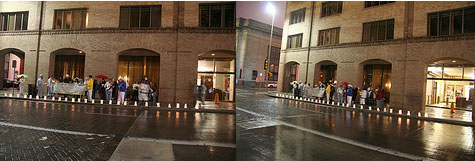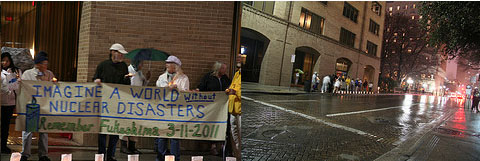Archive for the ‘CPS’ Category
CPS Energy launches help team
June 24, 2014
By Vicki Vaughan
San Antonio Express-News

CPS CEO Doyle Beneby said the Customer Response Unit addresses a recurring concern.
CPS CEO Doyle Beneby said the Customer Response Unit addresses a recurring concern.
SAN ANTONIO — CPS Energy launched a new program Tuesday that’s designed to help customers take advantage of its energy efficiency programs and help those struggling to pay utility bills learn how to get assistance.
CPS CEO Doyle Beneby explained that in meetings with City Council, "one thing kept coming up — that we at CPS weren’t reaching all the places that we needed to" to inform customers about its services, especially its low-income assistance programs.
As a result, city-owned CPS has formed a new business unit whose mobile customer-service team will match CPS customers with the right program or service.
In some cases, the outreach employees will meet face-to-face with customers. Customers will be able to identify mobile team members because they’ll wear uniform shirts and drive hybrid vehicles bearing a Customer Response Unit logo.
The outreach plan is designed to make customers aware of various CPS programs that can help them manage or lower their utility bills.
The Casa Verde program, for example, provides an average of $5,000 in free home weatherization improvements for those who qualify.
District 5 Councilwoman Shirley Gonzales praised CPS’ new program, saying she’d initially asked the utility to send an employee to her district office a couple of days a week to help with customers’ problems.
"So this is beyond what our expectation was, because it was only going to be for District 5 residents," Gonzales said. "Now this will be for people in the whole city who need it. It’s a much more focused approach to help people."
Maria Koudouris, CPS’ community engagement vice president, said the outreach team will handle customers’ problems that can’t be handled by the utility’s call centers.
For example, if a senior citizen has fallen behind in paying a bill, it may be caused by the timing of a Social Security payment.
"We’ll set them up with a better payment plan … and we’ll take more of a holistic approach" to see if the customer qualifies for weatherization or another assistance program, Koudouris said.
To qualify for the weatherization program, a customer’s income must be no more than 200 percent of the federal poverty level.
"There’s a whole menu of programs that we have, and we’ll try to get a lot more customers into those programs," she said.
About half a dozen CPS employees will be part of the outreach group "and it could grow from there," CPS spokeswoman Lisa Lewis said.
Koudouris said CPS initially will work with Merced Housing Texas, a nonprofit that provides affordable housing, and the George Gervin Youth Center to get the word out.
Chuck Landy Jr., vice president of community and government affairs at the Gervin center, said it receives many calls from people asking how they can get help in paying their utility bills.
"This assistance from CPS will make a difference," Landy said.
Gervin center officials plan to aid the CPS team by doing their own outreach to tell the community about CPS programs.
"We’ll bring in all of our resources at the Gervin center," Landy said.
Also Tuesday, CPS said it is extending summer hours at its customer service centers to 7:30 a.m. to 8:30 p.m. Monday through Friday for residential customers.
Saturday hours — 8 a.m. to 5 p.m. — remain the same.
This document contains copyrighted material whose use has not been specifically authorized by the copyright owner. SEED Coalition is making this article available in our efforts to advance understanding of ecological sustainability, human rights, economic democracy and social justice issues. We believe that this constitutes a "fair use" of the copyrighted material as provided for in section 107 of the US Copyright Law. If you wish to use this copyrighted material for purposes of your own that go beyond "fair use", you must obtain permission from the copyright owner.
Call for an end to nuclear power in San Antonio, Reactor safety and concerned scientists, CPS Energy plans and public opinion
MARCH 14, 2012
The QueQue
San Antonio Current
Call for an end to nuclear power in San Antonio


It was a dank, dark, drizzly Luminaria-less night, but a dozen-plus protestors trudged past the Federal Building downtown Saturday night with a banner calling on the few squinting drivers and umbrellaed pedestrians to "Imagine a World Without Nuclear Disasters." They walked down César Chávez Boulevard before hanging a right on Navarro Street to take up a position on the sidewalk outside CPS Energy‘s offices. Every few minutes someone tried to get a chant going, "Sayonara nuclear power" being the clunker in the bunch, and members of Energía Mía lit candles to place on the curb in memory of not only the thousands that died following the 9-magnitude earthquake and resulting tsunami in Japan a year ago, but for the victims likely still to come from the radioactive contamination wrought by the triple meltdown and hydrogen explosions at the Daiichi nuclear complex at Fukushima. "I would like to see us go to a zero nuclear power position," said a bearded Allen Townsend, who has tracked energy issues since the 1970s. "My big concern is the waste. Some of that waste is like a 20,000-year half-life, and I don’t think we can take care of something that long. That’s mortgaging the future."
Former City Councilmember Maria Berriozábal, the lone council opponent to STP 1 and 2 when they were constructed in the 1980s, said she hopes the units now being reviewed for license extensions that could have them operating until almost 2050 instead of shuttering in the late 2020s fail the test. "They’re old. They’re shut down as we speak because of problems. And we’ve seen all the problems that we’ve had in other cities," she said. "We should just concentrate all of our efforts on the good job that CPS is doing on sustainable energy and just quit nuclear energy." Lamenting the health risks that come from nuclear, former elementary teacher Helen Villarreal agreed, adding that the United States is losing an opportunity to be a leader in the field of low-polluting energy sources such as solar, wind, biomass, and geothermal.
Radioactive contamination from what may be the world’s worst nuclear disaster has blanketed the countryside around Fukushima and poured into the Sea of Japan, contaminating many domestic products and impacting the nation’s export business. Radioactive fallout was even tracked to cities in the United States. While regulators insist the minute levels of radioactive cesium and iodine, for instance, don’t pose a health risk here, two researchers publishing in the International Journal of Health Services found that 14,000 "excess" U.S. deaths – particularly among infants – may be linked the radioactive fallout from Fukushima. The gap represents the same sort of double-minded approach within the research community that still divides opinions about the Chernobyl nuclear disaster of 1986. An international collaboration of researchers have pinned the estimated fatalities linked to Chernobyl at 5,000 nearby and about 30,000 worldwide. However, reports filed by physicians in Ukraine and Russia published by the New York Academy of Sciences claim the death toll wrought by Chernobyl has already approached a million dead.
Reactor safety and concerned scientists
As some of the last reactors to go online in the U.S., STP also enjoys one of the stronger safety records in the fleet, said Buddy Eller, spokesperson for the STP Nuclear Operating Company. And if Fukushima Daiichi’s disaster was brought on by the loss of connection to the electrical grid from earthquake damage and backup generators swamped by the resulting tsunami – a double-whammy above and beyond what the reactors were built to sustain – Eller expressed confidence in STP’s three emergency safety systems that include "locomotive-sized" diesel generators in "flood-proof" concrete bunkers. Annual Assessment letters from the U.S. Nuclear Regulatory Commission for 2011 dated March 5, 2012, also give Texas nukes, the South Texas Project and Comanche Peak in North Texas, clean bills of health. "The NRC determined that overall, South Texas Project Electric Generating Station Units 1 and 2 operated in a manner that preserved public health and safety and met all cornerstone objectives."
But the Union of Concerned Scientists blasted the U.S. Nuclear Regulatory Commission in a report last week for failing to enact key recommendations from its own post-Fukushima assessment. "Many of its proposals to safeguard against such a calamity here are good in principle," the report states, "but their effectiveness will depend on how well they are implemented, and how quickly." High on their complaint is the NRC’s unfulfilled charge to clarify "patchwork" regulations for severe accidents (those exceeding the abilities of the plants to withstand, see Fukushima). In fact, such action, while highest on the NRC’s list of priorities, will be some of the last actions to be implemented, the UCS report states.
CPS Energy plans and public opinion
Plans to double the 1,080-megawatt nuclear-power complex in Matagorda County responsible for a full third of greater San Antonio’s power fell through after ballooning expenses in 2009 gave way to internal bickering and lawsuits between partners CPS, NRG Energy, and Toshiba in 2010, but members of Energía Mía want the city to fully divest itself from what they consider an "unforgiving" power source. It’s a non-starter at CPS, where an emailed response to questions on the subject reads simply: "CPS Energy has not evaluated elimination of nuclear from its energy portfolio and does not have any plans to do so." Whether STP 1 and 2 will be closed in 2028 or 2048, increased maintenance and repair will be the name of the game for years to come. Unit 2, for instance, has been offline for several months now as crews work to replace a rotor in the main generator, Eller said. Yet in order to fulfill its goal of 20 percent renewables by 2020 and a full 65 percent of its energy supply from "low-carbon" sources, CPS is pursuing non-nuclear and non-coal options vigorously. "Mothballing Deely in 2018 and acquiring a gas plant to replace Deely’s 870 MW along with wind, solar and clean coal is helping us get there," spokesperson Christine Patmon said. CPS announced this week that it is purchasing an 800-megawatt combined-cycle gas plant in Seguin. In January, a deal for 400 solar megawatts from OCI Solar was announced. How well the "bridge fuel" play on natural gas works out will hinge a lot on the environmental costs of shale gas development and the durability of formations like the Eagle Ford in South Texas (see "Inflated figures").
Meanwhile, a recent survey by ORC International performed Last month for the Civil Society Institute found that 57 percent of Americans (extrapolated from a survey of 1,032) are less supportive of nuclear power post-Fukushima. "This survey is another piece of bad news for new nuclear construction in the U.S.," said Peter Bradford, a former NRC commissioner and current adjunct law professor on nuclear power and public policy at Vermont Law School, said in a prepared release. "The nuclear industry has spent millions on polls telling the public how much the public longs for nuclear power. Such polls never ask the real world questions linking new reactors to rate increases or to accident risk. Fukushima has made the links to risk much clearer in the public’s mind."
This document contains copyrighted material whose use has not been specifically authorized by the copyright owner. SEED Coalition is making this article available in our efforts to advance understanding of ecological sustainability, human rights, economic democracy and social justice issues. We believe that this constitutes a "fair use" of the copyrighted material as provided for in section 107 of the US Copyright Law. If you wish to use this copyrighted material for purposes of your own that go beyond "fair use", you must obtain permission from the copyright owner.
CPS pursues shift from coal to natural gas
Friday, November 18, 2011
Utility will bid on 800-megawatt plant that could power 200,000 houses.
By David Hendricks
San Antonio News-Express
CPS Energy will know by year’s end whether it will be successful in acquiring a natural-gas plant that would largely replace two coal-fired plants set to be retired by 2018, executives said Thursday.
Once CPS gets a plant, it will seek to buy natural gas produced by the Eagle Ford shale operations in South Texas, said Doyle Beneby, the utility’s president and CEO.
The city-owned utility will place its bid in the coming weeks for an undisclosed natural-gas plant near San Antonio with a generation capacity of 800 megawatts. The buyer will be determined in December, and the sale is likely to close in the first quarter of 2012, said Cris Eugster, CPS chief sustainability officer.Eight-hundred megawatts from a natural-gas plant is enough to power about 200,000 houses, Eugster said.
Acquiring a natural-gas plant is part of the utility’s policy to reduce use of carbon-emitting fuels, Beneby told several hundred people at the Forum on Entrepreneurship breakfast held by St. Mary’s University’s Bill Greehey School of Business.
"We’ll be in the market for natural gas, and what better place than sitting on top of the Eagle Ford?" Beneby asked.
"Instead of shipping coal from Wyoming, we will be buying gas from locals," he added.
Shutting down the Deely coal units by 2018 means less particulate emissions, Beneby said.
Eugster said natural gas-fired electricity plants use one-third the water of coal-fired plants and emit about half the greenhouse gases.
The utility is in the midst of collecting bids, for the third time, on a proposed 400-megawatt solar project — enough to power 80,000 homes. Bidding began Monday and concludes Dec. 7. Previous rounds were scrapped because late bids came in, reflecting quickly falling solar equipment prices.
CPS added new minimum requirements for bids, including creating at least 800 jobs, establishing a $30 million annual payroll, and making $100 million in manufacturing capital investments. The utility staged an online conference Thursday to assist companies planning to submit bids.
Beneby said that even though CPS Energy’s possible investment in the expansion of the South Texas Project nuclear plant is on hold, he’s hoping for more nuclear power long-term.
The 1979 Three Mile Island accident set back the U.S. nuclear industry about 25 years, and Japan’s tsunami-related damage this year will set it back another three to four years, Beneby said.
If the U.S. military disarms some of its plutonium-based weapons arsenal, some of that material might be mixed with uranium to provide new domestic-source fuel for nuclear plants, he added.
This document contains copyrighted material whose use has not been specifically authorized by the copyright owner. SEED Coalition is making this article available in our efforts to advance understanding of ecological sustainability, human rights, economic democracy and social justice issues. We believe that this constitutes a "fair use" of the copyrighted material as provided for in section 107 of the US Copyright Law. If you wish to use this copyrighted material for purposes of your own that go beyond "fair use", you must obtain permission from the copyright owner.
Beneby making mark at CPS Energy
07/02/2011
Kathy Clay-Little
San Antonio Express-News
A green economy creating jobs. When President Barack Obama was running for president in 2008 and talked about the green economy being an economic generator, it really sounded like pie in the sky to many.
To a nation long accustomed to and long reliant upon fossil fuels to light, heat and cool their homes and buildings, prepare their meals and get them from point A to point B, the green economy was years in the future.
The future just moved miles closer in San Antonio with the recent announcement by CPS Energy that it has formed partnerships with five companies that will thrust San Antonio to the forefront of the green economy. Three of the five companies are moving their headquarters to San Antonio, along with about 120 immediate jobs.
And, to put an exclamation point to the announcement and let the San Antonio community know that it is moving full force ahead into a green energy economy, CPS Energy CEO Doyle Beneby made another big announcement: CPS will be closing the J.T. Deely coal- fired plant by 2015, 18 years earlier than projected.
That, if nothing else, is an indicator of Beneby’s commitment to take CPS in a different direction, one significantly less reliant on fossil fuels.
Prior to coming to CPS Energy, Beneby worked for Exelon Power, in the private sector and not in the role of CEO. Stepping in the role of CEO of the nation’s largest municipally owned utility company, he faced some enormous challenges. Chief among them was restoring confidence in the utility after the debacle surrounding the South Texas Nuclear Project.
Beneby was hired in August and took the reins from Milton Lee on Sept. 1, so he’s been at the job less than a year. He’s already set the tone for where he is taking CPS Energy.
The marrying of a municipally owned utility with the area’s economic development is a big, bold step, one that some will say is outside the realm of what they want their utility company to be doing.
However, when one looks at what CPS Energy has invested in the South Texas Nuclear Plant and the relative benefits to San Antonio in terms of its economy, it seems that Beneby has carved out a new "right direction" for the utility in positioning it to be ahead of the curve in the coming green economy if it actually does turn out to be more than a pie in the sky dream.
While environmentalists are, no doubt, happy with Beneby this week for making such a huge commitment to green energy and closing the pollutant- spewing Deely plant, that honeymoon most likely won’t last forever.
When I interviewed Beneby earlier this year, he talked about the importance of diversifying CPS Energy’s sources of energy for its customers if San Antonio consumers are to continue to have low-cost energy and clean energy.
The energy that the Deely plant is generating will need to be replaced, and solar and wind energy are not at the point, nor are they likely to be so by 2015, that they can take up the slack.
Nuclear energy has to be a part of our city’s energy future, and Beneby has to lead us in that direction, too.
Kathy Clay-Little is publisher of African American Reflections.
This document contains copyrighted material whose use has not been specifically authorized by the copyright owner. SEED Coalition is making this article available in our efforts to advance understanding of ecological sustainability, human rights, economic democracy and social justice issues. We believe that this constitutes a "fair use" of the copyrighted material as provided for in section 107 of the US Copyright Law. If you wish to use this copyrighted material for purposes of your own that go beyond "fair use", you must obtain permission from the copyright owner.
Solar’s woes minimal in comparison
By Lanny Sinkin
Guest OpEd – San Antonio Express-News
Thursday, March 31, 2011
Proponents of nuclear and fossil fuels are claiming all energy sources, including solar, have risks. ("All forms of energy have risk," Business, March 26). When you delve into the true nature of those risks, there really is no comparison.
There is no solar accident that even begins to approach the destructiveness of a nuclear reactor meltdown. Solar relies on a reactor that is perfectly placed — 93 million miles from Earth.
A major solar spill is what we call a nice day, hardly comparable to the Deepwater Horizon killing 11 people and producing a massive release of oil.
Replacing fossil fuel-generated electricity with solar dramatically reduces green house gases and helps to mitigate the worst effects of climate instability — a benefit, not a risk.
To compare solar risks to the risks from continued reliance on nuclear and fossil fuels is not rational, let alone logical.
The solar risks identified in the article are that "solar is expensive" and "hard to deploy at the necessary scale."
Solar costs are already below the price of proposed new nuclear projects. The price of nuclear projects will almost certainly increase as a result of the Japan catastrophe. The real cost of the Japanese nuclear plants will now include the billions of dollars spent to contain the meltdowns and deal with the aftermath.
Southern California Edison chose a future based on solar, rather than natural gas, for economic reasons. Solar costs are also within the competitive range with coal when the cost of building a coal plant is included. If coal had to pay for its health, environmental and climate-change damage, coal would not compete with solar.
As to installing enough to meet demand, I asked an engineer involved in developing the San Diego solar plan to estimate the amount of solar we could put on rooftops in San Antonio. His back-of-the-envelope estimate was 4,000 megawatts. By way of comparison, the new Spruce 2 coal plant is 750 megawatts.
The sidebar to the article says the best locations for solar "are far from population areas, so they require costly transmission infrastructure." While solar potential to the west is higher, we don’t need to go there. San Antonio rooftops are highly productive and feed into the existing transmission infrastructure.
The sidebar says "solar can’t be stored (although solar heat can for a while)." There is a concentrated solar plant being built in Spain that heats up an oil that stores enough heat to generate electricity for 15 hours after the sun goes down. There is ice storage, compressed air, pumped water, flywheels and a host of other storage technologies rapidly maturing or already in use.
The sidebar then gets ridiculous by saying, "Turbines and panels pose a threat to birds." There are problems with wind turbines killing birds and bats. We know of no recorded instance of a solar panel harming a bird in any way.
San Antonio can believe the spin and reluctantly move forward on solar. Or we can follow the bold leadership coming from CPS Energy and make San Antonio the national leader in solar.
We can build as much solar as we have the will to build. The real risk would be a failure to fully embrace our solar potential.
Lanny Sinkin is executive director of Solar San Antonio.
This document contains copyrighted material whose use has not been specifically authorized by the copyright owner. SEED Coalition is making this article available in our efforts to advance understanding of ecological sustainability, human rights, economic democracy and social justice issues. We believe that this constitutes a "fair use" of the copyrighted material as provided for in section 107 of the US Copyright Law. If you wish to use this copyrighted material for purposes of your own that go beyond "fair use", you must obtain permission from the copyright owner.


